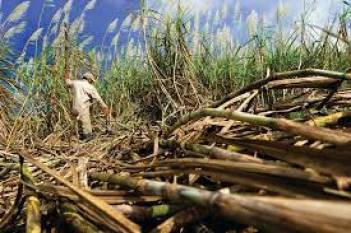50 MN sugarcane farmers to benefit
NEW DELHI, 20 June 2021: Secretary, Department of Food and Public Distribution, Sudhanshu Pandey briefed the media persons about ethanol blending with petrol (EBP) program.
The roadmap for ethanol blending in India 2020-25 has been released by the Prime Minister Narendra Modi on 5 June, 2021 on World Environment day. Notification regarding making E 20 fuel available by April, 2023 has been issued.
It may be noted that BIS specifications for E12 & E15 blending have also been notified on 2nd June, 2021. Pilot project of E 100 dispensing from 3 locations at Pune was also launched by the Prime Minister.
Secretary, DFPD said that as a result of various measures taken to address demand and supply side issues, it is likely that ethanol distillation capacities in the country would be more than doubled by 2025 and we would be able to achieve 20 percent blending target.
Pandey said that EBP will bring positive impact on country’s economy too. He said that it would promote ethanol as a fuel which is indigenous, non-polluting and virtually inexhaustible and would improve the environment and the eco-system as use of E20 fuel reduces carbon monoxide emission by 30-50 percent and hydrocarbon by 20 percent.
To achieve blending targets, Government is encouraging sugar mills and distilleries to enhance their distillation capacities for which Government is facilitating them to avail loans from banks for which interest subvention up to 6 percent is being borne by Government.
He said that the production of fuel grade ethanol and its supply to OMCs has increased by 5 times from 2013-14 to 2018-19.
In ESY 2018-19, we touched a historically high figure of about 189 crore litres thereby achieving 5 percent blending. It is expected that in current ethanol supply year 2020-21, more than 300 crore ltrs ethanol is likely to be supplied to OMCs to achieve 8 to 8.5 percent blending levels. It is also likely that we would be achieving 10 percent blending target by 2022.
To invest INR 41,000 in capacity addition / new distilleries
He further informed that due to upcoming investment of about INR 41,000 crore in capacity addition / new distilleries, various new employment opportunities will be created in rural areas and strengthen the agricultural economy.
Pandey said this would save foreign exchange of more than INR 30,000 crore on account of crude oil import bill and would reduce dependence on imported fossil fuel thereby would help in achieving the goal of Atmanirbhar Bharat in petroleum sector.
Over 3.5 MT of sugar to be diverted for ethanol production
Pandey said in the next sugar season 2021-22, about 3.5 million tonnes of sugar is estimated to be diverted & by 2025 about 6 MT of sugar is targeted to be diverted to ethanol, which would solve the problem of excess sugarcane/sugar and would also help sugar mills in clearing cane price dues of farmers.
In past 3 sugar seasons about INR 22,000 crore revenue was generated by sugar mills/ distilleries from sale of ethanol to OMCs, Pandey said adding that about 5 crore sugarcane farmers & their families and 5 lakh workers associated with sugar mills & other ancillary activities would be benefitted with this intervention. Sugarcane farmers will get timely payment of sugarcane dues as the realization from sale of ethanol is much faster than sale of sugar.
It may be noted that India is facing a situation of plenty with surplus sugar, leading to liquidity problem to sugar mills and delayed payments of cane dues. The Government is encouraging sugar mills to divert excess sugarcane to ethanol which is blended with petrol.
Secretary, DFPD further briefed that till year 2014, ethanol distillation capacity of molasses-based distilleries was less than 200 crore litres. Supply of ethanol to OMCs was only 38 crore litres with blending levels of only 1.53 percent in ethanol supply year (ESY) 2013-14.
Capacity of molasse - based distilleries have been doubled
However, in past 6 years due to the policy changes made by the Government, the capacity of molasse- based distilleries have been doubled and are currently at 445 crore litres. Capacity of grain-based distilleries are presently about 258 crore litres.
Pandey added that for ethanol supply year 2020-21, Government has now increased the ex-mill price of ethanol derived from various feed stocks on the basis of raw material cost and conversion costs.
To increase production of fuel grade ethanol, government is also encouraging distilleries to produce ethanol from rice available with FCI and maize, Pandey pointed out.
Government has fixed remunerative price of ethanol from maize & FCI rice. To produce ethanol/alcohol from food grains, more than 165 LMT of additional food grains would be utilized; this extra consumption of surplus food grains would ultimately benefit the farmers as they will get better price for their produce and assured buyers and thus, will also increase the income of crores of farmers across the country.
Briefing about hand sanitizers, he said that prior to Covid-19, the annual production of hand sanitizer was about 1 million litre per annum and was mainly used in the hospitals. Keeping in view the crucial role of sanitizer in the fight against COVID-19, DFPD coordinated with Industry and State Governments to encourage industry to produce sanitizers.
With the collective efforts of DFPD & State Governments, more than 900 distilleries/independent units were accorded permissions to produce hand sanitizer. Installed capacity for production of hand sanitizer increased substantially to 3 million litre per day.
As on 31 May 2021, around 3.9 Crore litre of hand sanitizer has been produced. In view of surplus availability of sanitizer in the country, export of sanitizer has also been allowed earning tremendous amount of goodwill for the country Pandey added.
Image credit: Scidev.net























